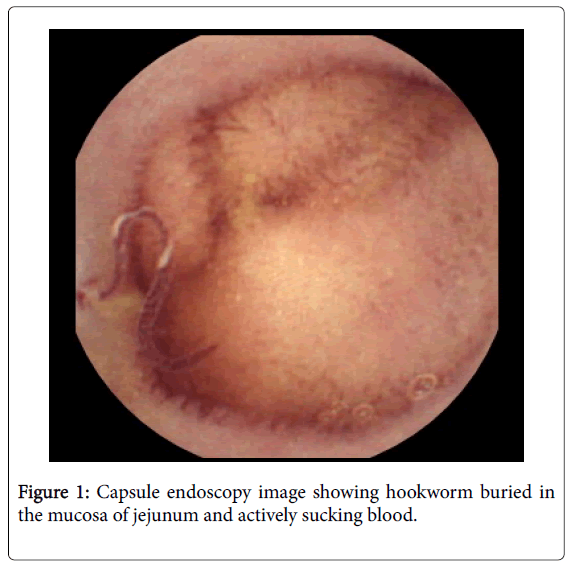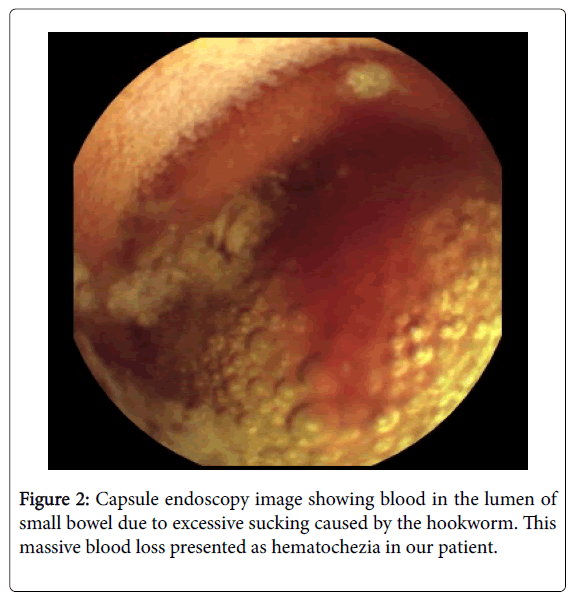Case Report Open Access
Capsule Endoscopy Demonstrating Blood Sucking Hookworms as A Cause of Obscure Gastrointestinal Bleeding
Varun Gupta*, Praveen Sharma, Ashish Kumar, Vikas Singla, Naresh Bansal, Ravi Daswani and Anil AroraInstitute of Liver, Gastroenterology and Pancreatico-Biliary Sciences, Sir Ganga Ram Hospital, New Delhi, India
- *Corresponding Author:
- Varun Gupta
Institute of Liver
Gastroenterology and Pancreatico-Biliary Sciences
Sir Ganga Ram Hospital
New Delhi, India
Tel: 91-9810209611
Fax: 98-615-3265361
E-mail: varun_doc@yahoo.co.in
Received Date: March 15, 2017; Accepted Date: March 24, 2017; Published Date: March 27, 2017
Citation: Gupta V, Sharma P, Kumar A, Singla V, Bansal N, et al. (2017) Capsule Endoscopy Demonstrating Blood Sucking Hookworms as A Cause of Obscure Gastrointestinal Bleeding. J Infect Dis Ther 2:315. doi: 10.4172/2332-0877.1000315
Copyright: © 2017 Gupta V, et al. This is an open-access article distributed under the terms of the Creative Commons Attribution License, which permits unrestricted use, distribution, and reproduction in any medium, provided the original author and source are credited.
Visit for more related articles at Journal of Infectious Diseases & Therapy
Abstract
Hookworm infestation will usually present with iron deficiency anemia. In this report we present a case of obscure overt gastrointestinal bleeding occuring from last two years in a young individual, requiring 50 units of blood transfusion. He was diagnosed with hookworm infection on a capsule endoscopy, which demonstrated dancing worms buried in the mucosa of small bowel and were actively sucking blood. He was treated with a short course of mebendazole and recovered completely. Capsule endoscopy can be useful in diagnosing hookworm infection if other modalities fail.
Keywords
Hookworm; Capsule Endoscopy; Obscure Gastrointestinal bleeding
Case
A young boy of age 14 years was referred at our center with two years history of intermittent hematochezia. There was no associated pain in the abdomen, fever, and diarrhea. He was investigated earlier and was diagnosed with iron deficiency anemia. He was managed with repeated blood transfusions and received 50 units of blood transfusions in last two years. He underwent repeated esophagogastroduodenoscopy (EGD), colonoscopy and radiographic contrast studies of intestines earlier, which were reported to be normal.
At our center, the results of hematological examination showed hemoglobin 5.86 g/dL, red blood cell count 2.43 × 1012/L, white blood cell count 4.5 × 109 /L (including 5% eosinophil granulocyte). We also performed an esophagogastroduodenoscopy (EGD) and colonoscopy, which were normal. In view of obscure gastrointestinal bleeding, capsule endoscopy was performed which demonstrated multiple hookworms in the proximal and mid jejunum. Hookworms were seen buried partially in the wall of jejunum and were seen actively sucking the blood with dancing movements (Video 1). Sucked blood could be appreciated in the cavity (pseudocoelom) of hookworms, giving red colored to hookworms. White colored hookworms were lying quiescent in the small bowel. Blood could also be seen in the cavity of small bowel, thus causing hematochezia to the patient (Figures 1 and 2). Antihelminthic (Mebendazole 100 mg, twice daily for three days) and iron supplements (for 3 months) were prescribed to the patient. On follow up, he improved clinically within 4 weeks, and his hemoglobin increased spontaneously to 11 gm/dl after 3 months.
Obscure gastrointestinal bleeding (OGIB) is defined as occult or overt bleeding of unknown origin that persists or recurs after an initial negative endoscopic evaluation including colonoscopy and EGD. The introduction of capsule endoscopy over the past decade has had a major impact in the diagnosis of OGIB. Parasites are an uncommon cause of obscure gastrointestinal bleeding but not in tropical countries like India.
Ancylostoma duodenale and Necator americanus are the hookworm species affecting the human beings. An Italian physician, Dubini, first described hookworm in 1838, after an autopsy. Iron deficiency anemia, one of the common health diseases can occur due to mechanical sucking of blood and due to blood loss secondary to release of anticoagulants by the worm. But if the hookworm infestation is high the bleed can be severe and patient can present with obscure overt gastrointestinal bleeding (hematochezia), as in our case.
Conventionally hookworm diagnosis is usually made by evaluation of stool for the eggs. Recently, newer small bowel imaging modalities like capsule endoscopy and double balloon enteroscopy has identified hookworm as a cause of obscure gastrointestinal bleeding [1,2]. Multiple worms can be identified feeding on the mucosa of the small intestine and they appear red in color or they can be identified in the luminal cavity and appear white in color. Presentation can be with gastrointestinal bleed, iron deficiency anemia or pain abdomen [3]. Usually hookworms are identified in distal small bowel but can rarely also be diagnosed on an EGD [4].
Conventionally hookworm infestation is found commonly in Asian population [5]. But, due to massive migrations of populations, physicians all over the world should think about hookworm as a cause of obscure gastrointestinal bleeding in young individual. It is important to prevent the infection by avoiding barefoot walking and maintenance of food hygiene [6,7]. Treatment with antihelminthic, albendazole (400 mg as a single dose) or mebendazole (100 mg twice daily for 3 days) is highly effective and simple. Clinician should not miss this treatable cause of anemia, and even if the stool samples are normal one can use advance endoscopic modalities to identify undiagnosed cases without any other apparent proven cause of anemia.
References
- Ghoshal UC, Venkitaramanan A, Verma A, Misra A, Saraswat VA (2015) Hookworm infestation is not an uncommon cause of obscure occult and overt gastrointestinal bleeding in an endemic area: A study using capsule endoscopy. Indian J Gastroenterol 34: 463-467.
- Yi F, Huang M (2013) Obscure gastrointestinal bleeding caused by hookworms. Braz J Infect Dis Off Publ Braz Soc Infect Dis17: 270-271.
- Wang P, Li RZ, Huang ZY, Tang C-W (2013) Report on 55 cases of small intestine hookworm disease diagnosed by capsule endoscopy. Zhongguo Ji Sheng Chong Xue Yu Ji Sheng Chong Bing Za Zhi 31: 140-142.
- Singla V, Gupta V, Kumar A, Sharma P, Bansal N, et al. (2016) Duodenal Hookworm- An Endoscopic Diagnosis. J Infect Dis Ther 4: 268.
- Chen JM, Zhang XM, Wang LJ, Chen Y, Du Q, et al. (2012) Overt gastrointestinal bleeding because of hookworm infection. Asian Pac J Trop Med 5: 331-332.
- Hotez PJ, Brooker S, Bethony JM, Bottazzi ME, Loukas A, et al. (2004) Hookworm infection. N Engl J Med 351: 799-807.
- Hotez PJ, Pritchard DI (1995) Hookworm infection. Sci Am 272: 68-74.
Relevant Topics
- Advanced Therapies
- Chicken Pox
- Ciprofloxacin
- Colon Infection
- Conjunctivitis
- Herpes Virus
- HIV and AIDS Research
- Human Papilloma Virus
- Infection
- Infection in Blood
- Infections Prevention
- Infectious Diseases in Children
- Influenza
- Liver Diseases
- Respiratory Tract Infections
- T Cell Lymphomatic Virus
- Treatment for Infectious Diseases
- Viral Encephalitis
- Yeast Infection
Recommended Journals
Article Tools
Article Usage
- Total views: 4657
- [From(publication date):
April-2017 - Jul 15, 2025] - Breakdown by view type
- HTML page views : 3773
- PDF downloads : 884


